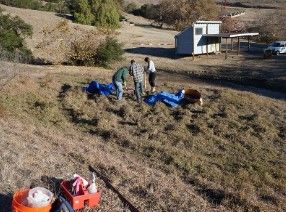Soil classification, or scientific identification, can also help determine if the soil needs extra attention and resources for protection. For example, certain soils may not be safe for hiking, could be home to an endangered species, or foster a unique ecosystem like wetlands.
However, soil classification is complex. Soil characteristics include color, texture, mineral composition, air and water content, and much more. Each of these characteristics can give added details to solve the story behind the soil.
Many soils are simple for trained soil scientists to identify. But Karen Vaughan of the University of Wyoming and her team dug in to investigate an area of soil along the central coast of California that had some peculiar characteristics.
“The reason for this research site really comes from long ago in a wetlands field lab,” she says. “Students kept saying the soil didn’t meet all the field indicators of hydric — or wetter — soils. I thought, it has to. It’s wet and there’s plenty of water-loving vegetation. Then I realized it must be a problematic soil, so we set up this experiment to figure it out.”
Vaughan’s experiment consisted of studying how dark the color of the soil was, as well as its water content, vegetation, and chemical composition. Looking at how wet the soils seemed, the vegetation that grew there, and microbes that lived there, a scientist would think they were wetland soils.

Researchers work together to dig a soil pit in a slump block wetland in Poly Canyon along the central coast of California.
However, other characteristics of the soil, such as its dark color, confused the researchers because it was so similar to the surrounding drier soil. This is where a way to analyze soil color more precisely, called the profile darkness index, was helpful. It allowed them to properly classify the soils.
Soil classification is usually a pretty exact science. Hydric soils have a specific set of characteristics. One of the key characteristics of hydric soil is a pale, light greyish color. As a result of the uniquely dark color, they could be mistakenly identified as drier soils and not meet the requirements of wetlands.
More clues for soil classification can sometimes be found in the landscape. Landslides are common on these cliffs, which cause soil to fall and be deposited in other areas. Often, these landslides result in depressions where a soil might be wetter than its surroundings.
“We get these situations where the soil characteristics don’t match features we usually see in wetter soils,” Vaughan explains. “This is, for example, because the transported soils inherited darker colors from the parent material. If someone looked at these soils, they would assume they are not as wet as they are. They then would not classify these areas as wetlands, despite them performing as wetlands.”
Click here to see more...